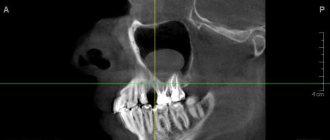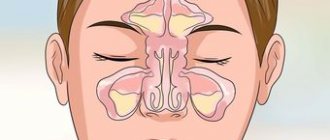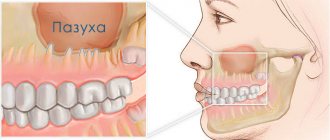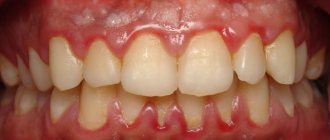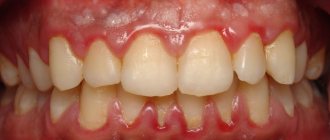Polyps in the maxillary sinus appear as a result of chronic inflammatory processes. When growing interfere with breathing, cause chronic runny nose and headaches. Without diagnosis, they are poorly differentiated from other otolaryngological diseases. As a rule, treatment in a clinic according to a unified protocol does not bring results.
Our Center has been specializing in providing care to patients with pathologies of the maxillary sinuses for more than 20 years. The ENT department is equipped with modern diagnostic and functional equipment. Surgical treatment is performed by maxillofacial surgeons with ENT training.
Causes
Polyps of the maxillary sinuses are the most frequently detected formations. These are benign neoplasms of the mucous membrane in the form of processes on thin stalks or a wide base. They grow from infected tissues against the background of inflammatory processes, and are combined with the sinus mucosa by connecting elements.
Polyps in the maxillary sinus (nasal polyps)
Main causes:
- frequent infectious diseases without treatment
- chronic inflammation of the maxillary sinus
- hereditary metabolic disorder, immune system malfunction
- sinus damage, presence of foreign bodies after dental treatment
- inflammation of the tooth root at the border with the sinus
- predisposition to allergies
Risk group
There is a certain risk group for developing nasal polyps. “These are people who work in unfavorable enterprises with a certain harmfulness. We are talking about dusty rooms, closed, with poor ventilation. And if a person breathes such air for years, then his risks increase,” says Vladimir Zaitsev. And, of course, those at risk are those who have a hereditary predisposition.
Soppy story. How to rinse your nose without mistakes Read more
Why are polyps of the maxillary sinuses dangerous?
The insidiousness of the disease is that small polyps do not cause any inconvenience. They grow slowly, without arousing suspicion for years. In our practice, there are situations when they are discovered by chance on a computer tomogram during preparation for treatment, extraction or implantation of teeth. And this is a great success for the patient; timely treatment can be undertaken at the initial stage without radical methods.
Otherwise, the polyps gradually grow, causing inconvenience to the point of blocking breathing . A worried patient runs from one ENT doctor to another. But the hope for a high-quality, timely examination in the clinic is weak; an appointment for a computed tomography scan of the sinuses can be waited for months. And standard drug treatment prescribed without the necessary diagnostics does not help. It is good when a doctor refers a patient to a specialized institution, even at the expense of his own reputation.
Initially, polyps are benign formations, but they are prone to degeneration into malignant ones . Sometimes there is a decrease in size, but these are rare cases. Therefore, when they are detected, you need to keep the situation under control. The best solution to the problem is removal of polyps to eliminate oncological problems.
Complications
Polyps can cause a number of unpleasant consequences for the body.
The first problem is that a person switches to mouth breathing. The natural way of breathing is through the nose, because... The air passing through the nasal cavity is warmed, moistened and purified. When nasal breathing is impaired, a person begins to breathe through the mouth, and the air enters the lower respiratory tract unwarmed and polluted. This means there is a risk of getting pharyngitis, bronchitis, pneumonia, etc. increases significantly.
The second problem is impaired ventilation of the paranasal sinuses. This leads to frequent sinusitis (sinusitis, sinusitis, sphenoiditis, ethmoiditis). These diagnoses are dangerous and, if not treated correctly, can lead to dangerous complications, such as sepsis or meningitis.
Problematic breathing through the nose can cause breathing pauses during sleep - obstructive apnea. These are the first signs of the development of cardiovascular diseases.
Polyps aggravate the course of bronchial asthma and intensify its symptoms.
Overgrowths of mucous membrane in the nose that appear in infants interfere with proper sleep and sucking milk: this leads to malnutrition, weight loss, problems with the respiratory and digestive systems, a deviated nasal septum, problems with teeth, bite and other facial deformities.
Symptoms
- congestion in one or both nostrils
- feeling of constriction in the nose and throat
- lack of smell perception
- pain in the facial area
- often pain and pressure are projected onto the orbit, ear canal
- runny nose with copious mucus, frequent sneezing
If polyps of the maxillary sinuses are not removed in a timely manner, the neoplasms slowly grow, causing:
- hearing loss
- voice change
- conjunctivitis
- nosebleeds
- chronic headaches
- softening of surrounding bone tissue
- deformation of adjacent anatomical structures
- infection of the teeth at the border with the sinuses
Polyps are dangerous due to the possibility of tumors blocking the respiratory tract, even leading to death from suffocation
Treatment of polyps
Conservative therapy is used to treat polyps at an early stage of development. Drug therapy for polyps may include:
- corticosteroid drugs in the form of tablets for oral administration;
- local corticosteroid drugs in the form of nasal drops and sprays;
- antihistamines;
- antibiotics (if polyps provoked sinusitis);
- immunomodulators.
If the patient turned to an otolaryngologist late, or drug therapy did not help, the question arises of surgical removal of the polyps. Indications for surgical treatment are:
- large polyp size (from 7 millimeters or more);
- long-term, persistent nasal congestion;
- increased incidence of bronchial asthma;
- increased frequency of sinusitis;
- severe curvature of the nasal septum;
- bloody discharge from the nasal passages;
- snore.
There are several options for performing the operation.
The most common method is removal of the polyp with a loop. This is the most painful method and is accompanied by bleeding. In this case, the doctor removes only visible polyps. Part of the polypous tissue may remain after such removal, and the polyp will grow again. This technique is often used in district clinics, because There is no more modern equipment in such medical institutions. A more gentle method is removal using a radio wave loop of the Surgitron surgical device. But the risk of reappearance of the polyp after such an operation also remains.
Another method is laser removal. The laser is inserted into the nose and evaporates the formation. The risk of bleeding is small. Removal is carried out under endoscopic control, which allows the doctor to act purposefully. The disadvantage of the operation is the inability to remove polypous tissue from the sinuses, which provokes the risk of relapse.
Rhinoshaver polypotomy (removal with a shaver). A rhinoshaver (or microdebrider) is a device that is inserted into the nasal cavity, cuts off the polyp and immediately crushes it, sucking the crushed tissue into a reservoir. This is a non-traumatic and bloodless surgical technique. Removal is carried out under endoscopic control. After such an operation, the likelihood of re-formation of polyps tends to zero.
After the operation, so-called post-relapse therapy is carried out, including taking antihistamines, corticosteroids, rinsing the nasal passages with saline solutions, and visiting the nasal cavity with an ENT doctor.
Why you should entrust treatment to the ENT department of dentistry
70% of patients who turned to us for help were previously treated in city clinics with many drug courses and traumatic operations in the form of sinus punctures. But, unfortunately, such methods are not able to get rid of polyps. A tumor in the paranasal sinuses can only be eliminated through surgery.
ENT dentistry is a comprehensive approach to the treatment of tumors in the maxillary sinuses. It combines two areas - otolaryngology and dentistry, allowing you to combine options for dental and ENT treatment .
Intervention in the maxillary sinuses requires highly qualified and trained physicians. Only a maxillofacial surgeon with ENT training can cope with such a task without complications . In addition, special high-tech equipment is required.
Polypous rhinosinusitis (polyps of the nasal cavity)
Nasal polyps are outgrowths of hypertrophied mucous membrane of the nasal cavity or paranasal sinuses. Nasal polyps have an imperceptible gradual course and lead to severe disturbances in nasal breathing, a decrease or complete absence of the sense of smell. Difficulty breathing through the nose can result in headaches, sleep disturbances, decreased performance, hearing impairment, malocclusion and speech development in children. Nasal polyps are diagnosed based on the results of an endoscopic examination of the nasal cavity, X-ray and tomographic examination of the paranasal sinuses. Additionally, pharyngoscopy, otoscopy, general blood test, and bacteriological studies are performed. Nasal polyps, as a rule, are subject to surgical removal with postoperative and anti-relapse treatment.
Nasal polyps are a fairly common pathology. According to various statistics, they are observed in 1-4% of people. Mostly adults suffer from nasal polyps. The formation of nasal polyps is associated with excessive growth (hypertrophy) of the nasal mucosa, which usually occurs as a result of a long-term inflammatory process. The fact is that the nasal mucosa constantly fights the inflammation occurring in it, trying to weaken or compensate for the pathological reactions that arise. However, over time, the protective functions of the mucous membrane are depleted. Then the following compensatory mechanism is activated - this is an increase in the area of the mucous membrane due to its hypertrophic growth, as a result of which nasal polyps appear.
Causes
Nasal polyps are a polyetiological disease. Factors contributing to the appearance of polyps in the nasal cavity include:
- anatomical features of the structure of the nasal cavity (deviated nasal septum, narrow nasal passages);
- chronic inflammatory processes in the paranasal sinuses (frontal sinusitis, sinusitis, ethmoiditis);
- allergic diseases of the respiratory tract (hay fever, allergic rhinitis, asthmatic bronchitis, bronchial asthma);
- cystic fibrosis.
Symptoms of nasal polyps
As a rule, nasal polyps begin to grow in the ethmoid sinus and the upper parts of the nasal cavity. At the beginning of their development, these changes in the nose remain barely noticeable to the patient. Over time, nasal polyps slowly increase in size, which leads to gradually progressive difficulty in nasal breathing. To facilitate breathing through the nose, the patient begins to use vasoconstrictor nasal drops. At first, they really bring relief because they reduce swelling of the mucous membrane. However, with large nasal polyps, vasoconstrictor drops cease to have any effect. It is during this period that most patients first turn to an otolaryngologist with complaints of nasal congestion and difficulty breathing through the nose.
Impaired nasal breathing associated with nasal polyps leads to increased fatigue of patients, decreased mental performance, headaches and sleep disturbances. Patients complain of a deterioration in their sense of smell, up to a complete lack of perception of smells (anosmia). There may be a feeling of a foreign body or constant discomfort in the nose, various changes in taste sensations. Most patients with nasal polyps experience a runny nose and frequent sneezing. There may be pain in the paranasal sinuses.
The large size of nasal polyps leads to the appearance of a nasal tone in the voice. Overgrown polyps can block the entrance leading from the nasopharynx to the auditory tube, resulting in decreased hearing (hearing loss), and in children - impaired speech development.
The appearance of nasal polyps in childhood due to the lack of normal nasal breathing causes improper formation of the facial skull and dental system, which is most often manifested by various malocclusions. In children of the first year of life, nasal polyps and difficulty in nasal breathing cause problems with sucking and swallowing food, which leads to chronic malnutrition and malnutrition of the child.
Complications of nasal polyps
Normal nasal breathing ensures warming and humidification of the air entering the nasal cavity, as well as clearing it of dust particles that settle on the nasal mucosa and are gradually eliminated with its secretions. Nasal polyps, preventing the passage of air through the nasal cavity, force the patient to partially or completely replace nasal breathing with breathing through the mouth. As a result, dry and cold air enters the respiratory tract. Thus, the disruption of nasal breathing that occurs with nasal polyps leads to the development of diseases such as pharyngitis, laryngitis, tracheitis, laryngotracheitis, bronchitis, and pneumonia.
Nasal polyps can block the communication of the paranasal sinuses with the nasal cavity, which favors the occurrence of an inflammatory process in them and the development of sinusitis. Large polyps in the nose lead to compression of blood vessels and impaired blood circulation in the tissues of the nasopharynx, which in turn causes frequent inflammation of the pharyngeal tonsil with the development of adenoids, palatine tonsils with a clinical picture of tonsillitis or chronic tonsillitis, the auditory tube (eustachitis) and the middle ear (otitis).
Diagnosis of nasal polyps
A nasal tone in the voice allows one to identify impaired nasal breathing even in the absence of patient complaints. In children, problems with breathing through the nose are indicated by the very appearance of the child: an open mouth, drooping of the lower jaw, smoothness of the nasolabial folds. The next diagnostic step is to determine the cause of impaired nasal breathing, which can be not only nasal polyps, but also adenoids, choanal atresia, sinusitis, a foreign body or benign tumor of the nose, synechiae of the nasal cavity. The patient undergoes rhinoscopy, which, in the case of nasal polyps, reveals characteristic grape-shaped growths of the mucous membrane.
To assess the degree of growth of nasal polyps, a CT scan of the paranasal sinuses is performed. Patients undergoing surgical treatment of nasal polyps are required to undergo a CT scan, since the results of computed tomography allow the surgeon to determine in advance the scope of the operation and develop appropriate tactics for its implementation. If it is not possible to use computed tomography in diagnostics, the condition of the sinuses is examined using radiography of the paranasal sinuses.
Detection of diseases of the nasopharynx accompanying nasal polyps is carried out by pharyngoscopy, microlaryngoscopy, otoscopy, bacterial culture of nasal discharge and a throat smear. When assessing the activity of the inflammatory process, the data of a clinical blood test (degree of leukocytosis, ESR level) are taken into account. Patients who develop nasal polyps due to allergic diseases undergo allergy tests.
Treatment of nasal polyps
Conservative treatment
Conservative treatment methods are aimed primarily at eliminating those factors that provoked nasal polyps. This includes excluding exposure to infectious agents and allergens on the body, as well as potential food allergens (dyes, flavorings, etc.); sanitization of foci of chronic infection and treatment of inflammatory diseases of the nasopharynx; antiallergic therapy and immunocorrection. As a rule, conservative treatment of nasal polyps in itself does not give the desired result.
Therefore, it is usually used as the initial stage of combination therapy, after which nasal polyps are subject to surgical treatment, i.e., removal.
A conservative method is a method in which nasal polyps are removed using a special loop under local anesthesia. Its use is possible in patients who have restrictions on the use of surgical treatment methods due to the presence of respiratory failure, blood clotting disorders, decompensated hypertension, coronary heart disease, heart failure, severe bronchial asthma, etc.
Surgery
Indications for surgical treatment are nasal polyps, accompanied by impaired nasal breathing, impaired sense of smell, recurrent sinusitis, frequent attacks of bronchial asthma, snoring, occlusion, and deviated nasal septum. If nasal polyps are detected during an exacerbation of bronchial asthma or obstructive bronchitis, then surgical treatment is postponed until a period of stable remission of these diseases. Surgical removal of nasal polyps can be performed in several ways, differing from each other not only in the technique of execution, but also in the degree of trauma and effectiveness.
The method in which nasal polyps are removed using a polyp loop and other surgical instruments is still quite widely used. The main disadvantage of this method is that only those polyps that are located in the nasal cavity can be removed. Since in most cases nasal polyps originate from the paranasal sinuses, the polypous tissue remaining in the sinuses grows again with the rapid formation of new polyps. As a result, nasal polyps recur within the first two years after surgery. Other disadvantages of removing polyps with a loop include greater trauma and bleeding accompanying the operation.
Endoscopic removal is considered the most effective and modern method . It is accompanied by endovideosurgical visualization with an image of the surgical field displayed on the monitor. With the endoscopic method, nasal polyps are removed using a special power tool (microdebrider or shaver), which draws the polyp tissue into the hole of its tip and shave it off at the base. The high accuracy of the shaver and good visualization make it possible to carefully remove nasal polyps and polypous tissue located in the paranasal sinuses, which ensures a later occurrence of relapses in comparison with other methods of treating polyps. In addition, by removing nasal polyps endoscopically, the surgeon has the opportunity to correct the internal anatomical architecture of the nose in order to improve drainage of the paranasal sinuses. As a result, optimal conditions are created for the implementation of the most effective postoperative treatment, and subsequent surgical interventions, performed if necessary, to re-remove nasal polyps, are simplified.
Anti-relapse treatment
Due to the fact that nasal polyps are prone to frequent recurrence, after their surgical removal, mandatory postoperative and anti-relapse treatment is carried out. Postoperative care of the nasal cavity should be carried out within 7-10 days after surgery. It is advisable that the nasal toilet and rinsing of the nasal cavity be performed by an otolaryngologist. If this is not possible, the patient can independently rinse the nose with saline at home using a rubber bulb or syringe, and also use ready-made saline sprays for this purpose. In situations where nasal polyps are combined with allergies, antihistamines (Claritin, Erius, loratadine) are additionally prescribed.
For anti-relapse purposes, after removal of nasal polyps, three months of local treatment with corticosteroids is prescribed in the form of dosed inhalations for irrigation of the nasal cavity. With such local treatment with corticosteroids, they do not have a systemic effect and their inherent systemic side effects. Treatment with corticosteroids is most effective if nasal polyps were removed endoscopically, which ensures good patency of the channels connecting the nasal cavity with the paranasal sinuses, and thereby creates conditions for penetration of corticosteroids injected into the sinuses.
Patients with nasal polyps should be followed up by an otolaryngologist for at least 1 year after surgery. Visits to the doctor are recommended at least once every 3 months. Patients with allergies also need to be monitored by an allergist.
Forecast and prevention of nasal polyps
It should be noted that none of the treatment methods guarantees that nasal polyps will not reappear. A good result is considered if nasal polyps recur no earlier than 6-7 years after their removal. If not treated promptly, nasal polyps can lead to the development of persistent anosmia, in which the ability to perceive odors is not restored even after surgical treatment.
Prevention of nasal polyps consists of timely identification of allergic diseases, elimination of their causes and prescribing the correct treatment; early diagnosis of infectious and inflammatory processes in the nasopharynx and their elimination; preventing nasopharyngeal diseases from becoming chronic.
Diagnosis of polyps in the maxillary sinuses
During the examination, the main thing is to carry out a differentiated diagnosis to exclude other ENT diseases accompanied by similar symptoms
Upon visual examination, an increase in regional lymph nodes and swelling of the tissues in the area of the maxillary sinuses are observed.
X-ray examination in our Center is performed
on a computed tomograph in ENT mode .
Allows you to assess in detail the condition of the paranasal sinuses, determine the location and size of polyps. In difficult or controversial situations, the following may additionally be required:
- Videoendoscopy for examination of the nasopharynx and nasal cavity
- MRI to detect purulent fluid in the nasal appendages
- Bacteriological culture
Diagnosis of the disease
Your doctor can determine the condition based on your answers to questions about your symptoms, a physical examination, and rhinoscopy (a visual inspection of the nasal cavity using a light and a nasal speculum). But additional examination may be required to determine treatment tactics.
Additional diagnostic tests for polyposis:
- Endoscopic examination. Using an endoscope, the doctor can conduct a thorough examination of the nasal cavity.
- X-ray tomography. Images obtained by X-ray computed tomography (CT) provide information about the extent of polyposis involvement in the nasal cavity or sinuses. These tests can also help the doctor detect the presence of other abnormalities, such as a deformed nasal septum or enlarged nasal turbinates. Based on RCT images, the doctor may suspect a tumor growth other than polyposis (malignant or benign).
- Allergy detection. The doctor may prescribe an additional test to identify allergies: rhinocytogram, blood test for IgE, eosinophilic cationic protein, scarification tests. This is necessary in order to identify the presence of allergic pathology, which contributes to the development of polyposis.
- Test for cystic fibrosis (cystic fibrosis). A child diagnosed with chronic polypous sinusitis should be evaluated for cystic fibrosis. This is a hereditary disease that disrupts the secretion of glands, which leads to chronic inflammation of the respiratory tract and the development of polyposis.
Operation stages
Complex treatment is carried out in 1 day, we strive to combine all activities in one visit
- Preparation The operation is performed only after professional hygiene and sanitation of the oral cavity, and re-treatment of compromised dental roots. Sterility ensures there is no risk of infection.
- Removal Surgery according to the selected protocol for accessing the sinus with putting the patient to sleep with the simultaneous administration of an analgesic. Performed in a sterile operating room.
- Control X-ray examination CT after surgery is mandatory - to assess the quality of the operation performed and the condition of the maxillary sinus.
If a tooth with an inflamed root was removed, which provoked the growth of a polyp, after the operation the orthopedist will install a temporary orthopedic structure. You will never leave our Center without teeth.
On days 10-14, the sutures are removed and a control CT scan is performed. The patient is invited for a preventive examination and a convenient date for the visit is agreed upon.
Stages of development of neoplasms
The severity of signs and symptoms directly depends on the stage of the disease. When the tumor is small, a sign of its appearance is a feeling of congestion. This symptom looks like the beginning of a cold, so often at this stage a person does not diagnose and treat growths. Treatment boils down to the use of vasoconstrictor drops, which ultimately do not help. During this period, the body is more vulnerable to all kinds of infections, and otitis media, tonsillitis and other inflammatory diseases of the ENT organs can occur.
At the next stage, symptoms such as loss of smell and the appearance of a nasal voice appear. If the tumor blocks the opening of the auditory tube, signs of hearing loss appear.
In the third stage, the symptoms of the disease appear most intensely. Nasal discharge, headaches, constant congestion, breathing through the mouth - all these are signs that the polyp has reached an impressive size.
The symptoms of the disease are actually not as harmless as they look. To get rid of them, you must definitely contact an ENT doctor to prescribe competent treatment.
Unfortunately, few patients come to an otolaryngologist at the first signs of illness, when conservative treatment is still possible. Most of them turn to an ENT doctor when only surgical treatment can really help.
How is recovery going?
Rest assured that we will not keep you at the Center unnecessarily
No hospitalization
Even in advanced cases with complex localization of polyps, the operation takes no more than 2-4 hours. Waking up after medicated sleep is not accompanied by deterioration of the condition and pain. The use of low-traumatic treatment protocols and the accumulated experience of doctors allow us to perform the operation as carefully as possible in relation to you. Hospitalization with an overnight stay at the clinic is not required .
For elderly patients with chronic cardiovascular diseases, a postoperative recovery service is provided in a day hospital for several hours under the supervision of an anesthesiologist. In any case, you will spend the night at home, in a familiar environment.
Inpatient recovery is necessary if general anesthesia was used, which often leads to complications, weakness and exacerbation of chronic pathologies. If a patient is offered a hospital stay for several days, this means that the clinic does not have modern equipment and qualified surgeons, or they are “squeezing” money out of you.
Branded rehabilitation on the day of treatment
The author's accelerated rehabilitation program ensures complete elimination of unpleasant consequences in the form of swelling, hematomas, muscle spasms, and pain.
Medicines to take home
After the operation, you will receive a free set of necessary medications to avoid purchasing counterfeit products. You don't have to run around pharmacies looking for the right medication in your postoperative condition.
The package with medications contains instructions with recommendations in the postoperative period. Please follow them to avoid complications.
Consequences
When removing polyps, a person needs to listen to the opinion of a doctor. “Sometimes polyps are so small that the operation will not be noticeable, there is no point in fighting them like that. But when the polyps are very large and do not allow the nose to breathe, this provokes a rise in blood pressure, hypertension, cerebrovascular accidents, neurological conditions and diseases. Of course, in this case it makes sense to have surgery, because it is fraught with heart attacks, strokes, arterial hypertension and hypertensive crises,” says Vladimir Zaitsev.
Contraindications: who should be careful when removing polyps?
- General health – depending on the general somatic condition of the patient and the presence of concomitant pathologies, polypectomy can be performed under either local or general anesthesia. It is necessary to adequately assess surgical anesthetic risks and conduct preoperative preparation.
- Tendency to bleed . Inherited bleeding tendencies such as hemophilia (an inherited bleeding disorder) require special precautions to prevent serious intra- or post-operative complications.

